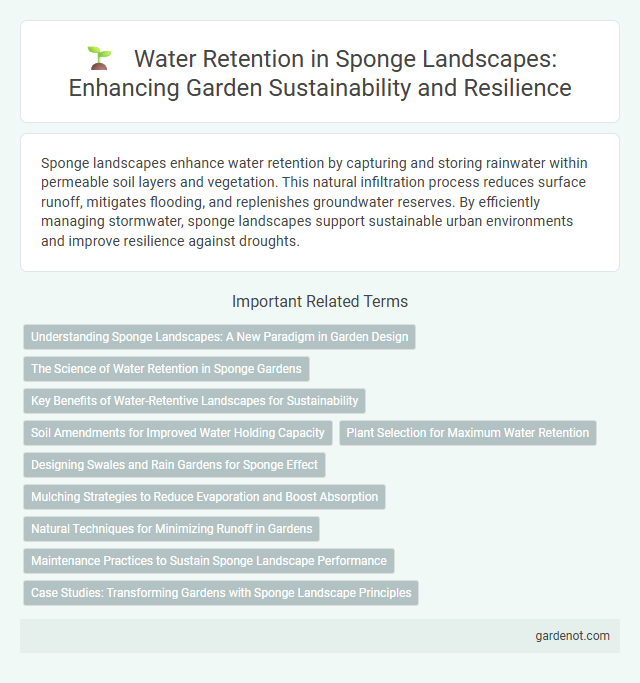Sponge landscapes enhance water retention by capturing and storing rainwater within permeable soil layers and vegetation. This natural infiltration process reduces surface runoff, mitigates flooding, and replenishes groundwater reserves. By efficiently managing stormwater, sponge landscapes support sustainable urban environments and improve resilience against droughts.
Understanding Sponge Landscapes: A New Paradigm in Garden Design
Sponge landscapes utilize permeable surfaces and strategically shaped soil to enhance water retention, reducing runoff and replenishing groundwater. This innovative garden design integrates native plants and mulch layers that promote infiltration and slow water flow, effectively managing stormwater. By mimicking natural hydrological cycles, sponge landscapes improve soil moisture, support biodiversity, and mitigate urban flooding.
The Science of Water Retention in Sponge Gardens
Sponge gardens utilize porous, organic materials that enhance soil's water retention capacity by mimicking natural spongy substrates found in forest floors. These materials create micro-reservoirs, allowing gradual water release to plant roots, reducing evaporation and runoff while maintaining optimal moisture levels. The enhanced water retention supports healthy plant growth, particularly in drought-prone or urban environments, by improving soil hydration and nutrient availability.
Key Benefits of Water-Retentive Landscapes for Sustainability
Water-retentive landscapes significantly enhance groundwater recharge by capturing and holding stormwater, reducing surface runoff and soil erosion. These landscapes improve plant health and biodiversity by maintaining consistent soil moisture, which supports resilient vegetation growth even during droughts. Implementing water retention features in sponge landscapes contributes to sustainable urban water management and mitigates flood risks in rapidly developing areas.
Soil Amendments for Improved Water Holding Capacity
Soil amendments such as biochar, compost, and clay minerals play a critical role in enhancing water retention in sponge landscapes by increasing the soil's capacity to hold moisture. These organic and mineral additives improve soil structure, porosity, and nutrient availability, which support prolonged water availability for plants. Incorporating soil amendments boosts infiltration rates and reduces surface runoff, promoting sustainable water management in xeriscaping and drought-prone environments.
Plant Selection for Maximum Water Retention
Selecting native deep-rooted plants such as switchgrass, sedges, and wildflowers enhances sponge landscape water retention by improving soil structure and increasing infiltration. Incorporating drought-tolerant species like lavender and rosemary reduces water loss while sustaining moisture levels. Strategic plant diversity maximizes evapotranspiration regulation, promoting consistent groundwater recharge and reducing surface runoff.
Designing Swales and Rain Gardens for Sponge Effect
Swales and rain gardens enhance water retention by capturing rainwater and allowing it to slowly infiltrate the soil, reducing runoff and replenishing groundwater. Designing swales involves shaping shallow, vegetated channels that direct water flow while maximizing sediment filtration and moisture infiltration. Rain gardens are strategically planted depressions with native plants that absorb and filter stormwater, contributing to the sponge landscape's ability to manage urban water sustainably.
Mulching Strategies to Reduce Evaporation and Boost Absorption
Mulching strategies play a crucial role in enhancing water retention in sponge landscapes by significantly reducing evaporation rates and improving soil moisture absorption. Organic mulches such as straw, wood chips, and compost form a protective layer that insulates the soil, maintains cooler temperatures, and promotes microbial activity essential for water infiltration. Applying a 2-4 inch thick mulch layer around plants increases water conservation, minimizes runoff, and supports sustainable landscape hydration.
Natural Techniques for Minimizing Runoff in Gardens
Sponge landscapes utilize natural techniques such as mulching, contouring, and the integration of native plants to enhance water retention and minimize runoff in gardens. These methods increase soil permeability and promote the absorption of rainwater, reducing erosion and conserving moisture. Implementing swales and rain gardens further supports groundwater recharge and prevents surface water loss.
Maintenance Practices to Sustain Sponge Landscape Performance
Maintaining soil moisture levels through regular mulching enhances the water retention capacity of sponge landscapes, reducing runoff and evaporation. Implementing periodic soil aeration and organic matter replenishment improves infiltration rates and sustains the sponge effect. Routine inspection and cleaning of in-ground permeable structures prevent clogging, ensuring consistent water absorption and retention.
Case Studies: Transforming Gardens with Sponge Landscape Principles
Case studies showcase how sponge landscape principles enhance water retention by incorporating permeable soils, rain gardens, and micro-catchments, significantly reducing surface runoff and increasing groundwater recharge. In urban residential gardens, these techniques have improved soil moisture levels by up to 40%, promoting healthier plant growth and reducing irrigation needs. Projects in cities like Singapore and Melbourne demonstrate effective stormwater management, transforming traditional gardens into sustainable, resilient ecosystems.
Water retention feature Infographic

 gardenot.com
gardenot.com